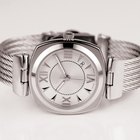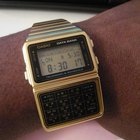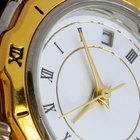Battery
Digital watches are a popular and important piece of technology that allow you to keep a portable measurer of time around with you. If you wear a digital watch, then you already know how useful it can be. Even better than traditional watches, these display numbers in an easy-to-read manner that even show in the dark. To begin to understand how these watches work, we have to start at the source of their power: the battery. Watch batteries are small, round and offer the power needed to work the watch. They are directly connected to a crystal oscillator.
Crystal Oscillator
A crystal oscillator is made out of quartz crystal and uses power from the watch's battery in order to create a 60-hertz signal. Each hertz represents one oscillation per minute, which is a necessary number in order for the watch to accurately display the time.
Counter
The crystal oscillator sends this signal, which is known as the time base, through a counter next. This is a preprogrammed device that begins to break up the time base by dividing it by certain numbers. First, it is divided by 10, and then again by 6. This sets up the clock to start counting seconds, which will allow it to accurately display what time it is. When the counter is done, a binary number is achieved.
Display
This binary number is then sent to a special microchip known as a "binary number to 7-segment display converter." Though it doesn’t have a fancy name, it does have one that tells you just what it is going to do. It is programmed to convert the binary number into a series of seven numbers. These all correspond to the hours, minutes and seconds of the current time. This time is then displayed on the face of the watch through LED lights that are controlled to display the numbers the chip comes up with. This is how a watch is able to display the accurate time.
Related Articles

How to Set the Time on a Casio AW-80

Casio Telememo 30 Watch Instructions

How to Set Manual Hands on a Casio AQ ...

How to Adjust the Time on a Casio ...

How to Set the Alarm on a Citizen's ...

Columbia Sportswear Watch Instructions

How to Turn the Alarm Off on a G-Shock ...

How to Adjust a G-Shock Watch

Casio Databank Instructions

How to Set a Timex Indiglo

How Do I Set Up My Casio Calculator ...

How to Set a Rolex Day-Date

How to Set the Analog Time on a Casio ...

Casio Wave Ceptor Instructions

Casio Illuminator Instructions

Instructions for Citizen Skyhawk ...

How Do I Troubleshoot a Timex Ironman ...

Casio Waveceptor 2735 Instructions

How to Start a Seiko Kinetic Watch

How to Set the Date & Time on an Omega ...